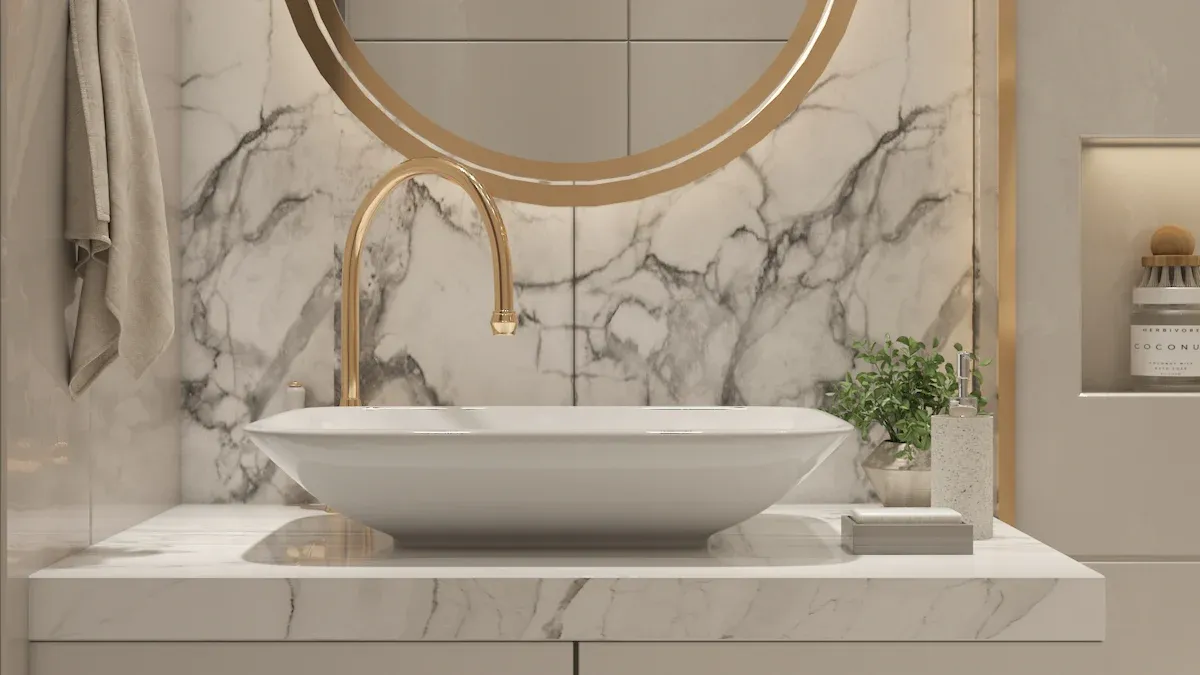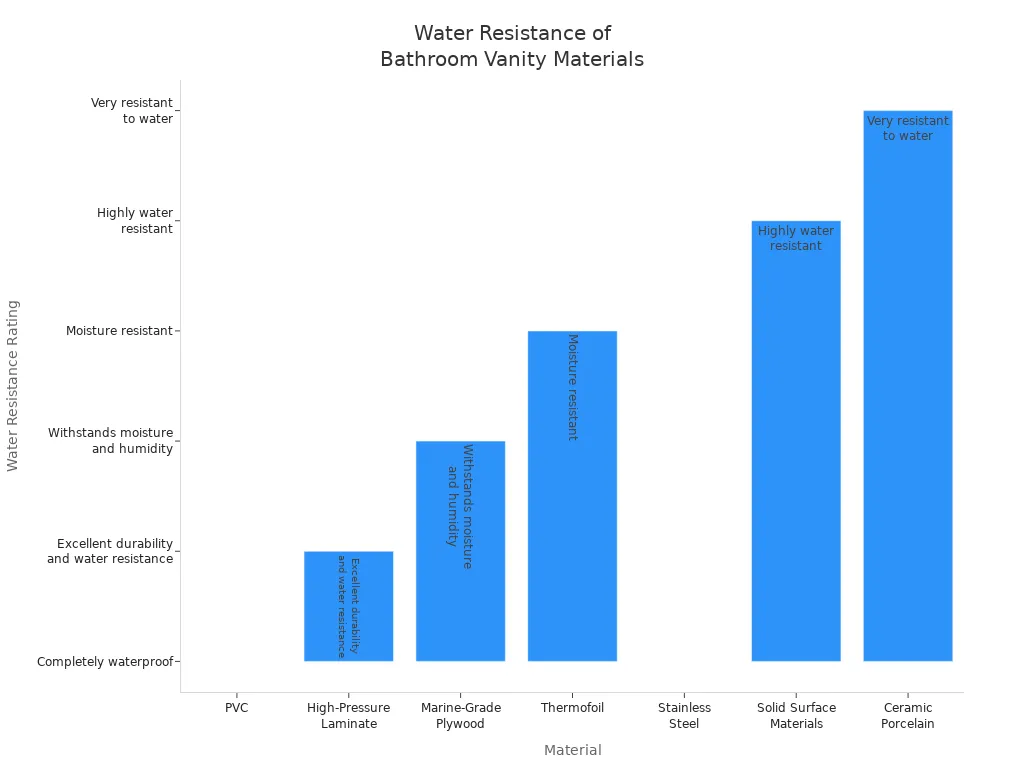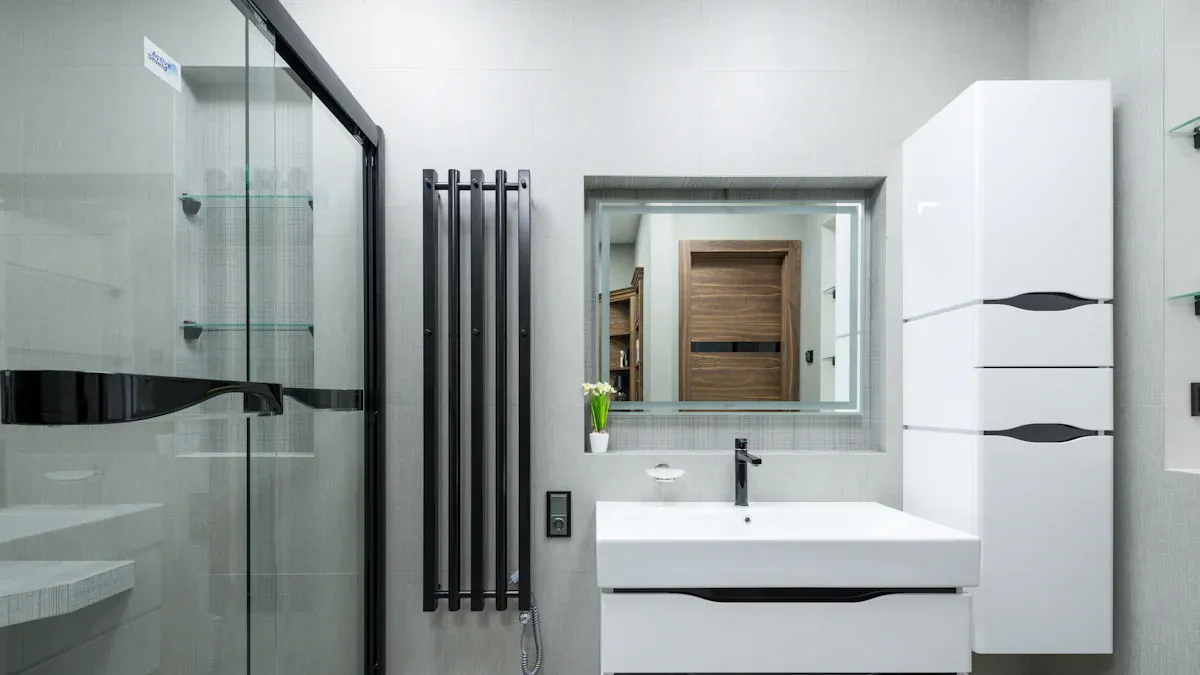
 FEEDBACK
FEEDBACK
If you are interested in our products and want to know more details, please leave a message here, we will reply you as soon as possible.


Imagine you go into your bathroom and smell something musty. You might also see cabinet doors under your sink that look bent. These things usually mean your bathroom vanity has water damage. You can tell if a vanity is really waterproof by looking for certain materials. These include PVC or marine plywood. Check if the edges are sealed and if the finish keeps out water. Waterproofing is important because bad air flow or leaks can cause problems. Cheap materials can also make the vanity swell, get stains, or grow mold. Look for smooth finishes and tight joints. Make sure the surfaces push water away to protect your bathroom vanity from harm.
Pick bathroom vanities made from waterproof materials like PVC, marine plywood, or stainless steel. This helps stop water damage.
Make sure all edges and joints are sealed tight with silicone or edge banding. This keeps water from getting inside.
Choose vanities with finishes that resist moisture, like semi-gloss paint or waterproof coatings. These finishes protect the surface from water and mold.
Clean your vanity often and dry up any water spills fast. This stops stains, swelling, and mold from growing.
Check the seals and finishes often. Reseal or fix them when needed. This helps your bathroom vanity stay waterproof and last longer.
If you want to know if a bathroom vanity is waterproof, look for some signs. These signs help you find vanities that can handle water and daily use. Here are the main things you should check:
The first thing to check is what the vanity is made of. Some materials are much better with water than others.
PVC is totally waterproof and does not need more sealing.
Marine-grade plywood and stainless steel also keep water out very well.
High-pressure laminate and thermofoil protect well but need sealed edges.
Solid wood, MDF, and particleboard only resist water a little and can get ruined if water gets in.
Tip: You cannot always tell if a vanity is waterproof just by looking at it. You need to know what it is made from.
Here is a table that shows how common materials compare:
Material | Water Resistance / Durability Notes | Pros | Cons |
|---|---|---|---|
PVC (Polyvinyl Chloride) | Completely waterproof | Lightweight, easy to clean, many styles | May not look like real wood, less sturdy if not supported |
High-Pressure Laminate | Excellent water resistance, needs sealed edges | Many colors, stain and scratch resistant | Expensive, edges must be sealed |
Marine-Grade Plywood | Designed for moisture, very strong | Durable, can look nice | More expensive, needs sealing |
Thermofoil | Moisture resistant, vinyl layer over MDF | Seamless, easy to clean | Can peel if edges are not sealed |
Stainless Steel | Fully waterproof, rust resistant | Modern look, easy to clean | Expensive, shows fingerprints |
Solid Surface (Corian) | Non-porous, highly water resistant | Many colors, stain resistant | Expensive, can scratch |
Ceramic/Porcelain | Very water resistant | Many designs, stain resistant | Heavy, brittle, needs skilled installation |

Water can get in through the edges and joints. You should pick vanities with sealed edges and joints.
Silicone sealant around sinks, counters, and corners keeps water out.
Edge banding on plywood or MDF covers open spots and blocks water.
Even the best materials need sealed edges to stay waterproof.
Note: If sealant is missing or cracked, water can get in. This can cause mold, swelling, or stains. Always check the edges and corners for smooth, full seals.
Here is an easy way to seal edges:
Take off old sealant.
Clean and dry the spot.
Use painter’s tape for straight lines.
Put on silicone sealant with a caulk gun.
Smooth the line and take off the tape.
Let the sealant dry all the way.
The finish on your vanity helps protect it from water and wet air.
Semi-gloss and satin paints work best because they fight water and are easy to clean.
Mold-resistant paints and primers help stop mold and mildew.
High-gloss finishes and waterproof paints give extra protection.
Matte finishes are not as good because they soak up water.
A good finish keeps your vanity looking nice and stops water from getting inside. Some vanities use special coatings like waterborne polyurethane, melamine, or acrylic for more protection. Edge banding and anti-mold treatments also help in wet bathrooms.
Moisture-Resistant Finish | Description | Best Use |
|---|---|---|
Semi-gloss/Satin Paint | Moisture resistant, easy to clean | Cabinets, doors |
Mold-Resistant Paint | Stops mold and mildew | Bathrooms, humid areas |
Waterborne Polyurethane | Flexible, waterproof coating | Wood surfaces |
Melamine/Acrylic | Durable, moisture resistant | Cabinet surfaces |
Edge Banding | Seals exposed edges | Plywood, MDF |
Remember: The right finish and sealed edges work with waterproof materials to keep your bathroom vanity safe from water damage.

PVC and plastic vanities are great at keeping water out. PVC boards take in less than 0.5% water. This means they do not swell or bend from water. These materials do not scratch or stain easily. They are simple to clean and care for. You can use them in bathrooms with lots of steam. PVC is light and does not cost much. But it can get weak and break over time. It also does not feel as strong as wood. Plastic coatings like acrylic also stop water well. They do not cost a lot. But they can scratch fast and do not like heat.
Material | Waterproofing | Durability (Years) | Maintenance | Notes |
|---|---|---|---|---|
PVC | Excellent | Low | Can become brittle, easy to clean | |
Acrylic | Good | 8–12 | Low | Prone to scratches, lightweight |
Tip: PVC and plastic vanities are best for places with lots of water.
Marine plywood uses glue that keeps water out. It does not swell or bend when wet. You can even put it in water for a long time. It will not lose its strength. HDF is thicker than MDF and keeps water out better. Both need to be sealed and finished right. If you skip this, water can get in and cause swelling or cracks. Marine plywood and HDF are smooth for paint or laminate. They cost more than regular plywood or MDF.
Stainless steel does not rust or break down. It has a thin layer that keeps it safe. If it gets scratched, the layer fixes itself. This keeps your vanity safe. Stainless steel vanities last over 20 years. You only need to clean them and check them sometimes. They do not let germs, stains, or heat hurt them. But they show fingerprints and water spots. Do not use strong cleaners. Wipe them dry after cleaning. Stainless steel is good for wet bathrooms and modern looks.
Stainless steel cabinets last long and are easy to clean.
Use mild soap and a soft cloth to clean them.
Good airflow helps stop rust.
Treated wood can keep water out if you use sealers. Sealers go into the wood and block water. You need to seal wood again every few years. Laminate covers things like MDF or plywood. It adds a layer that blocks water. If the laminate breaks, water can get inside and make it swell. Treated wood looks natural but needs more care than PVC or metal.
Other waterproof choices are ceramic, lacquer, and concrete. Ceramic is strong, easy to clean, and keeps water out. But it can break if you drop it. Lacquer looks nice and keeps water out but needs care. Concrete is strong and looks different. But it is heavy and needs sealing.
Material | Pros | Cons |
|---|---|---|
Ceramic | Heavy, can break | |
Concrete | Needs sealing, heavy | |
Lacquer | Looks nice, keeps water out | Needs care |
Start your inspection by looking at how your bathroom vanity is built. Good construction keeps water out and helps your vanity last longer. Use this table to guide your check:
Construction Feature to Check | Inspection Focus |
|---|---|
Waterproof membrane | Look for a layer around showers and tubs that blocks water. |
Backer board installation | Make sure there is a water-resistant board behind tiles. |
Floor tiling | Check if the floor slopes toward the drain to stop water from pooling. |
Grouting and sealing | Tiles should have grout and sealant to keep water out. |
Caulking and sealing | Look for smooth, unbroken caulk around fixtures and joints. |
You should also check for water-resistant backer boards, vapor barriers, and good ventilation. These features help stop moisture from getting into your vanity. If you see poor workmanship, like gaps or missing seals, water can get inside and cause mold or damage. Always look for manufacturer certifications that show the vanity meets waterproof standards.
Seals and joints are weak spots for water leaks. Check these areas often. Look for:
Mold growing near sealed spots
Water stains or leaks around joints
Discoloration or swelling near edges
If you see any of these signs, reseal the area right away. For best results, inspect high-risk areas every month, less risky spots every season, and do a full check once a year. This routine helps you catch problems early and keeps your bathroom vanity safe.
The finish on your vanity protects it from water. Check for moisture-resistant coatings on shelves and cabinets. Look at the finish on faucets and hardware to make sure they do not rust. Sealing around sinks and plumbing stops leaks. Use quality materials like solid wood, engineered wood, quartz, or granite for better water resistance. Make sure all finishes look smooth and have no chips or cracks. Proper installation and sealing keep your bathroom vanity waterproof for years.
You should clean your vanity every ten days. Use a soft cloth and a neutral detergent. This keeps the surface free from dirt and soap scum. After any water splashes, wipe the area dry right away. Water left on the surface can cause damage over time. Check plumbing connections often. Look for leaks or drips under the sink. If you spot any, fix them quickly to stop water from getting inside the cabinet. Open the doors sometimes to let air move through. Good airflow helps prevent mold and mildew. Use an exhaust fan during showers to keep the room dry.
Tip: Place heavier items on the bottom shelf. This reduces stress on the cabinet and helps it last longer.
Sealing keeps water out of wood and joints. For solid wood vanities, use a clear penetrating epoxy sealer. After that, apply two coats of marine varnish for extra protection. In areas with lots of water, choose a high-quality interior or marine varnish. Around sinks, use caulking to block water from seeping into cracks. If you notice the finish looking dull or worn, reseal the surface. For wood, apply wood oil once a year to keep it strong and healthy.
Maintenance Routine Table
Task | How Often | What to Use |
|---|---|---|
Clean surfaces | Every 10 days | Neutral detergent, soft cloth |
Wipe after water contact | Every time needed | Dry cloth |
Check plumbing connections | Monthly | Visual inspection |
Reseal wood surfaces | Yearly | Epoxy sealer, marine varnish |
Apply wood oil | Yearly | Wood oil |
Caulk around sinks | As needed | Waterproof caulk |
Standing water can shorten the life of your vanity. Always dry up spills and splashes right away. Make sure the area around the sink and faucet stays dry. Use mats or trays to catch drips from wet hands or bottles. Keep the bathroom well-ventilated. Turn on the exhaust fan or open a window during and after showers. This lowers humidity and helps surfaces dry faster. Regular care and quick action against water buildup help your vanity last for many years. With these steps, you can keep your vanity looking good and working well for a long time.
You can tell if a bathroom vanity is waterproof by looking at what it is made of. Check if the edges are sealed tight. See if the finish does not have chips or cracks. Cleaning your vanity often helps keep it safe from water. Resealing the edges also stops water from getting in. Here is a simple checklist to use when you shop or check your vanity:
Find vanities made with waterproof materials like PVC or stainless steel
Make sure the edges and joints are sealed well
Look at the finish and see if there are any chips or cracks
Pick waterproof features so your vanity lasts longer. Check your bathroom vanity today to keep it looking good and working well.
You can splash a small amount of water on the surface and edges. Wait a few minutes. If the water beads up and does not soak in, your vanity resists water. Wipe it dry after testing.
Yes. You can add sealant to the edges and joints. Use waterproof paint or varnish on the surface. Reseal any cracks or chips. These steps help protect your vanity from water damage.
Water inside the vanity can cause swelling, stains, or mold. You may notice a musty smell or warped wood. Fix leaks quickly and dry the area to prevent long-term damage.
You should choose a waterproof vanity for bathrooms with high moisture. Powder rooms or guest baths with little water use may not need full waterproofing. Waterproof vanities last longer and need less repair.
You should check the seals every year. Reseal if you see cracks, peeling, or dull spots. High-use bathrooms may need more frequent checks. Regular resealing keeps your vanity protected.